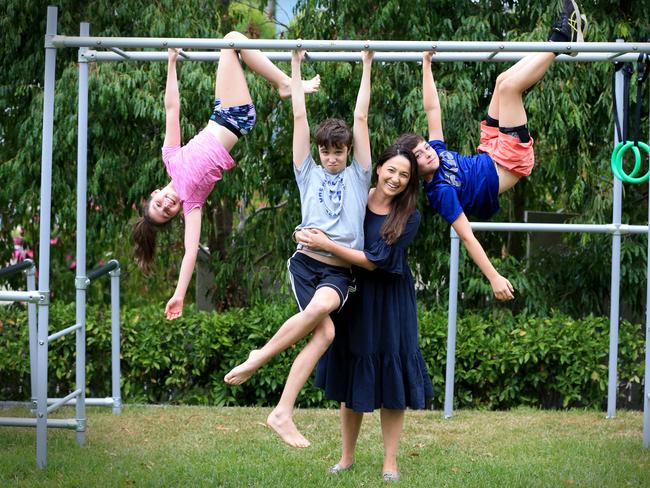Modern Qld children lagging in sporting ability
Modern Queensland kids are lagging previous generations in some vital metrics — and it has experts concerned.
QLD News
Don't miss out on the headlines from QLD News. Followed categories will be added to My News.
QUEENSLAND children can’t run, jump, kick, throw or catch as well as children from previous generations, worried sporting communities warn.
Sports authorities from a variety of codes have said the difference in ability is noticeable, with some organisations forced to adjust to meet players’ abilities.
Queensland girls’ schools revive ball games for 110th anniversary
Health and fitness: Bodybuilder dad advises parents to step up for kids
As president of the Beenleigh Netball Association for more than 30 years, Maree Robbins has observed the significant drop in sporting abilities.
“In yesteryear, children’s ability to run for lengths of time was much more promising, but that ability isn’t there any more,” Ms Robbins said.
“Kids used to have the endurance to last and last and last, now we’re having to teach them endurance and teach them how to run for long periods of time.
“Every child used to have a reasonable standard of fitness, but now it’s only the ones who work on it.”
Ms Robbins said she was concerned by some children’s inability to run 100m down the court.
“We see more obesity than we used to, and we see that exercise isn’t something that most kids do now, which really impacts on their sporting ability,” she said.

Her concerns reflect large-scale studies, with findings indicating Aussie kids’ vertical jump fell short of the 1985 average by 15-18cm, while a similar worldwide study ranked Australian kids’ activity 32nd out of 49 countries.
Co-author of one study, Professor Grant Tomkinson, formally of the University of South Australia, said the results were alarming.
“We should definitely be concerned about it,” Prof Tomkinson said.
“The likely culprits are increases in fatness and declines in physical activity.”
Peter Cummiskey, chief executive of Sports Federation Queensland (QSport) for more than 20 years, has noticed the decline in children’s activity.
“Children growing up in Australia today are very different to children of 20, 30, 40 years ago, when there was less concentration on risk,” Mr Cummiskey said.
“A generation ago, there was much freer rein.
“Lifestyle changes and all sorts of factors led to increased weight in the community. There’s less physical activity and, in general terms, that’s a factor in increasing difficulties of athleticism.”

Some groups, including Cricket Australia, have implemented wide-ranging changes to their junior sports.
In 2016 cricket’s national governing body revised the way young cricketers engaged in the sport, in an effort to cater to kids’ abilities, by introducing a shorter pitch and smaller bat and ball.
“There is a very noticeable change in the way children are introduced to cricket now compared to a few decades ago,” said Queensland Cricket’s general manager of Community Cricket, John Stock.
“Cricket has had to change the way we teach children basic skills at a young age. In the past, it may have been assumed that a child would know the basics of the game … how to grip a bat or bowl a ball, but our new junior formats are designed at much more of an entry level.
“Children are not playing cricket at home with their families like they may have done 20 years ago, but are perhaps introduced to the skills of the game when they attend a session at school or club for the first time.”

Mr Stock’s reasoning for the decline was similar to that of researchers, who blame “ease of accessing digital media and video games, time-poor parents, and more kids growing up without a back yard.”
As a mother to four young boys, Marissa Ryan of Tarragindi said having a small back yard was no excuse for her sons.
“We don’t have a big yard at home,” Ms Ryan said. “Our sons use the driveway and rumpus room as a cricket pitch, football field and basketball court.
“At times the motivation for keeping active can go a step too far, with Kai even practising his spin bowling inside the house.”
Ms Ryan said she valued her sons participating in organised sports for a few reasons, including the benefits to their gross motor skills and the importance of exercise.
TIPS FOR PARENTS
■ Kids should be doing at least 60 minutes of moderate to vigorous exercise every day
■ Children need to be partaking in bone- and muscle-strengthening exercises three times a week
■ Sedentary behaviour should be kept to under two hours a day
■ Long periods of sitting should be broken up
GET CRACKING
■ Organise a weekly roster of physical activities. Include walking the dog, going for a bike ride or run, and playing team sports
■ Encourage dancing, martial arts and aerobics
■ Allow kids to meet up with friends in person rather than chat over social media
■ Break up every hour of sitting with 20 star jumps
* Source: Federal Department of Health


